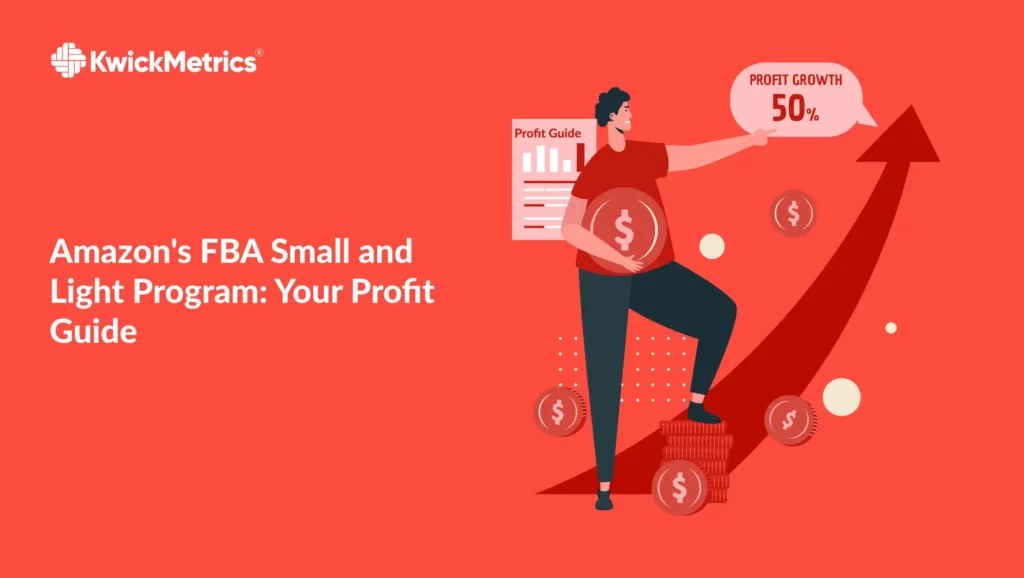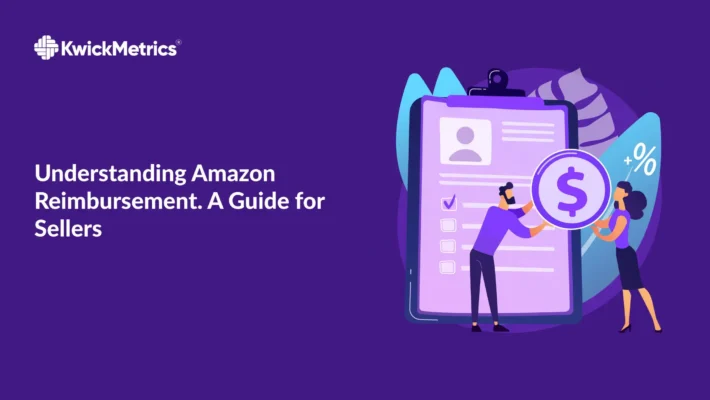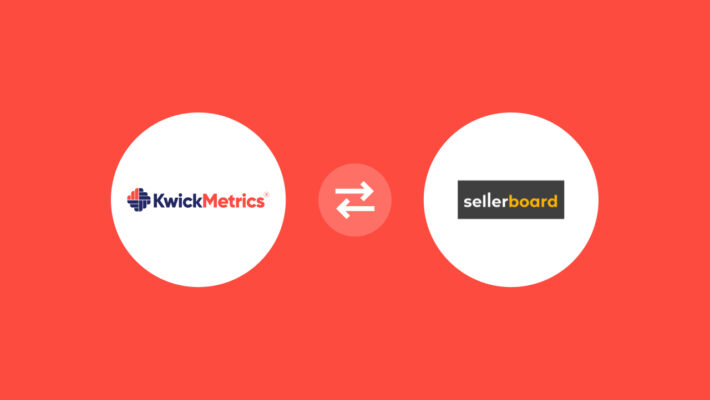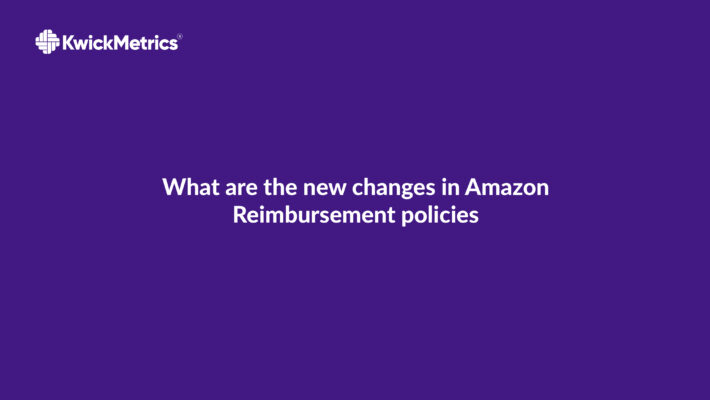Amazon’s FBA Small and Light Program: Your Profit Guide

Table of Contents
- Understanding the Amazon FBA Small and Light Program
- FBA Small and Light Enrollment
- Try Our KwickMetrics - One Tool with Multiple Solutions!
- FBA Small & Light Fees
- FBA Small & Light Vs Standard FBA
- Navigating Changes to the FBA Small & Light Program
- Boost Your Sales With KwickMetrics
- FAQs in Relation to Fba Small and Light
- Conclusion
Ever felt like you’re being nickeled and dimed with every little fee that pops up on your Amazon seller account? Like those small, light items are becoming a heavy burden due to excessive fees? I’ve been there. It’s like trying to juggle feathers in a windstorm – it seems easy until the winds of fulfillment costs start blowing.
You might be thinking: “Isn’t there a way around this?”
Enter Amazon FBA Small and Light Program. Picture it as an oasis for sellers amidst the scorching desert of hefty FBA charges, especially if you deal in lightweight, low-priced products. Amazon FBA Small and Light Program offers lower fees than standard FBA while ensuring fast delivery speeds which customers prefer.
But let’s not sugarcoat it. This plan, as perfect as it may seem, has its share of challenges and potential changes.
Understanding the Amazon FBA Small and Light Program
The FBA Small and Light program, an initiative by Amazon, is a godsend for sellers who deal with lightweight items. If you’ve ever questioned how to save on Amazon fees while ensuring fast FBA delivery speeds, this is your answer.
Benefits of Using the Amazon FBA Small and Light Program
This ingenious plan caters specifically to small, light products priced under $12. With its lower fulfillment rates compared to standard FBA rates, FBA Small and Light Program offers a cost-effective solution for those dealing in low-price merchandise. The idea here is simple – if your product’s size and weight fit within certain criteria (more on that later), you get charged less.
Besides lowering costs, another major perk lies in managing inventory efficiently. While conventional wisdom may suggest storing more stock during peak fulfillment periods like holiday seasons can lead to hefty aged inventory surcharges; with this FBA Small and Light program such issues are minimized as the monthly storage fee structure works differently.
How Does the FBA Small and Light Program Work?
The mechanics behind Amazon’s smartly designed system are pretty straightforward – they charge fees based on product dimensions rather than their actual weight or value. For instance: if an item fits into their predefined box sizes but weighs less than 1lb (the minimum quantity considered), then only box-size-based charges apply.
An important point worth noting though: starting August 29th of 2023 things will change as per recent updates from Amazon itself. So don’t wait too long before leveraging these benefits while they’re still available.
Aged Inventory Surcharge Explained:
-
- No Extra Fees: One standout feature is the lack of an aged inventory surcharge, a standard fee in Amazon’s regular FBA model. If you have items that are slow to sell, they won’t eat into your profits as much with this program.
- Delivery Speeds: It’s also worth noting that customers prefer faster delivery times and this program promises 3-5 day shipping speeds.
Key Takeaway:
Amazon's FBA Small and Light program is a boon for sellers dealing in lightweight, low-cost items. It offers reduced fees based on product dimensions rather than weight or value, efficient inventory management to avoid hefty surcharges during peak seasons, and faster delivery times.
FBA Small and Light Enrollment
If you’re an Amazon seller with lightweight, low-cost items in your catalog, then you might be considering enrolling in the FBA Small and Light program. This program is specifically designed for products that meet certain dimensions and price points. But how do you get started? And what are these criteria exactly?
FBA Small And Light Requirements
To enroll into this popular Amazon FBA Small and Light Program, your products need to tick a few boxes. First off, they must have dimensions no greater than 16 x 9 x 4 inches or weigh less than or equal to one pound.
The other key factor is price – all items should be priced under $12. Yes. You read it right; it’s as low as that.
Sadly though, like every good thing has its end date; the FBA Small and Light program too will cease accepting new product enrollments from July 18th of 2023. So if you’ve been sitting on the fence about joining up until now… well let’s just say time isn’t on our side anymore.
I know we don’t want to sound like party poopers but here’s another reality check: All those lovely temperature-sensitive products aren’t eligible for Amazon Small and Light Program either because they come under dangerous goods category by Amazon rules.
Now I bet some of y’all are wondering “But hey. What happens after July 18th?” Good question.
Well worry not my friend – Starting August onwards while we won’t see any more additions being made to this light brigade, sellers can still continue selling their existing enrolled inventory without any disruptions till end of August (29th) 2023 i.e., until small becomes standard so-to-speak.
Also remember folks… the minimum quantity to enroll in this program is 24 units per ASIN, and we have heard from many sellers that it’s been an effective way to manage inventory without worrying about aged inventory surcharge. So if you are someone dealing with a lot of SKUs then there’s definitely some food for thought right here.
Try Our KwickMetrics - One Tool with Multiple Solutions!
Key Takeaway:
Got lightweight, affordable items you're selling on Amazon? Think about the FBA Small and Light program. Hurry though - new sign-ups halt July 18th, 2023. To be eligible, products need to cost less than $12 and meet specific size requirements. You can continue to sell enrolled items till the end of August 2023. Just a heads up: there's a minimum enrollment of 24 units per AS.
FBA Small & Light Fees
Especially when dealing with the Amazon FBA Small and Light program, it’s essential to know about both referral fees and storage fees.
Understanding Amazon Referral Fees
When selling through Amazon, one of the costs that sellers need to consider are amazon referral fees. The amazon referral fee for each item is calculated as a proportion of the total sales price. So, if you sell more expensive items, expect your amazon referral fee to be higher too.
This may raise questions like “How much will I pay in referral fees?” or “Are there any ways I can reduce these Amazon Referral fees?”. To get answers for such queries, check out this detailed guide on Low-Price FBA Fee. It provides comprehensive information on how these charges work under different scenarios.
Amazon Fulfillment and Storage Fees in Detail
Moving onto fulfillment and storage fees – another significant expense area within the FBA small and light scheme. These charges vary depending upon factors like product size, weight etc., meaning they differ from product-to-product even within similar categories.
A key stat worth noting here: The Low-Price FBA rates per unit turn out to be $0.77 lower on average than standard FBA delivery speeds’ rates. That’s quite a savings considering every penny counts in e-commerce.
That’s a lot to take in, right? But understanding these charges can be pivotal for your business profitability. So it’s worth investing some time here.
When it comes down to calculating amazon fulfillment fees based on product size or weight, Amazon uses ‘dimensional weight’ (also known as volumetric weight). This concept may sound complicated but fear not. It simply combines the height, width and length measurements of your product package.
Want to dig more into how we figure out this fee? Check it in Low-Price FBA Rates guide.
Key Takeaway:
It's crucial for your business's success to understand Amazon's FBA Small and Light program fees. Don't forget the referral fees, which are a percentage of the total sales price, and the fulfillment/storage costs that change based on your product's size and weight. With Low-Price FBA rates per unit typically being $0.77 less than standard ones, getting to grips with these charges can be game-changing.
FBA Small & Light Vs Standard FBA
When it comes to Amazon’s selling plans, two programs often come up for discussion: the FBA Small and Light program and the Standard FBA. What advantages, disadvantages and expenses exist when comparing these two services?
The biggest difference between these two lies in their respective cost structures. For sellers dealing with low-priced items not previously enrolled in the FBA Small and Light program, there’s some good news. The new rates can significantly decrease your fulfillment costs. According to data from Amazon itself, certain items that are part of this plan will see a slight increase in cost per item under these fresh tariffs.
A key factor driving decisions on which option to pick is product size or weight – something both programs take into account when determining fees. The smaller (and lighter.) your products are, the more likely you’ll benefit from choosing ‘Small & Light’. But remember, as fast FBA delivery speeds become increasingly important for customers’ satisfaction levels too.
Determining Fees Based On Size And Weight In Both Programs
In both schemes – whether we’re talking about small and light Amazon FBA or standard ones – fees vary depending on several factors such as your inventory’s size or temperature-sensitive nature. As an example: while lightweight products might get charged lower fees through small and light change mechanisms within the former scheme; heavier goods could incur higher expenses due to additional handling required at fulfillment centers across America.
Navigating Through Recent Program Changes
From August 2023, Amazon plans to replace the FBA Small and Light program with new Low-Price FBA rates. These changes will impact all items priced below $10 – a move that might bring both joy and trepidation among sellers.
So, what’s the best part? On average, each unit’s FBA fees will be $0.77 less than the usual rate.
Key Takeaway:
Amazon's FBA Small and Light program can offer significant savings for sellers with low-priced, lightweight items. However, choosing between this and Standard FBA hinges on factors like product size or weight. Recent changes that came in August 2023 will replace the Small and Light program with Low-Price FBA rates, reducing average fees per unit by $0.77.
Navigating Changes to the FBA Small & Light Program
Staying abreast of modifications that could affect your Amazon business is essential for success. This year brings significant alterations with Amazon deciding to replace the FBA Small and Light program with Low-Price FBA rates starting August 2023.
The change means that all items priced below $10 will be eligible for these new Low-Price FBA Rates. But what does this mean for sellers like you? Let’s dig in.
A Shift Towards Low-Price FBA Fee
Recent times have seen buyers gravitating towards cheaper items on Amazon. To cater to this trend and help sellers manage inventory effectively, Amazon is making a bold move by replacing its popular FBA Small and Light program.
This strategic shift aims at benefiting both buyers who prefer more affordable options as well as sellers looking to sell such products without worrying too much about Amazon fulfillment fees or monthly storage charges.
New Fee Structure 2023: How Will It Affect Your Business?
Understandably, fee structures can be confusing even for seasoned amazon sellers. The transition from FBA small and light fees might raise questions about how things are calculated based on product size or weight now.
The good news is that Low-Price FBA rates per unit will average out around $0.77 less than standard FBA fees – meaning potential savings. However, compared directly with the outgoing small and light FBA fees model; they may appear slightly higher – averaging around an increase of $0.30 per item sold under this category.
Potential Implications For Your Profit Margins
The rise in costs may appear slight per unit, yet it could have an effect on your overall profit margins. If you are an Amazon seller dealing with large volumes of low-priced items, this increase might be more significant than anticipated.
We’re making changes to strike a balance – keeping fees competitive without piling too much on the sellers. As we navigate through this adjustment, our commitment to ensuring that your business remains profitable and sustainable is unwavering. We are actively monitoring the impact of these changes and are open to feedback, working collaboratively with sellers to optimize their success on the Amazon platform. Together, we strive to maintain a mutually beneficial partnership amidst evolving dynamics in the e-commerce landscape.
Key Takeaway:
Amazon's making waves, swapping out the FBA Small and Light program for Low-Price FBA rates from August 2023. This change caters to customers' love for low-priced items, possibly giving sellers a boost by lowering fulfillment costs. But keep your eyes peeled. While the revamped fee setup may be cheaper than standard charges, it's a bit pricier than what you're used to with the outgoing small.
Boost Your Sales With KwickMetrics
Explore 14-day free trial! No credit card required, cancel at any time.
FAQs in Relation to Fba Small and Light
What qualifies for Amazon FBA small and light?
Products eligible for the FBA Small and Light program should weigh less than 15.5 ounces, have dimensions under 16x9x4 inches, and be priced below $12.
What does FBA small and light mean on Amazon?
‘Small and Light’ refers to an Amazon program that offers reduced fulfillment costs for lightweight items with a low price point.
What is the minimum quantity for FBA small and light?
The minimum inventory requirement is 24 units per SKU when enrolling in the Small & Light Program.
Is Amazon Small And Light worth it?
Absolutely. The lower fees can make selling cheaper products more profitable while still providing fast Prime shipping to customers.
How long is shipping for FBA small and light?
Amazon customers without a Prime membership will also get free delivery within 6-8 business days.
Conclusion
Mastering the “FBA Small and Light” program can feel like a dance. You’ve learned the steps, seen how it benefits sellers dealing in lightweight, low-priced products.
The rhythm? Lower fees and faster delivery speeds which customers prefer. That’s a beat any seller could groove to.
But there are changes on the horizon; an incoming storm that may disrupt our dance. The end of this program in 2023 and transition towards Low-Price FBA rates – another routine we’ll need to learn.
You now have insights into enrollment criteria, associated fees comparison with Standard FBA – all key moves for your selling strategy ballet.
Your task? Stay nimble, adapt to changes swiftly so you don’t miss a step as Amazon’s music evolves.


